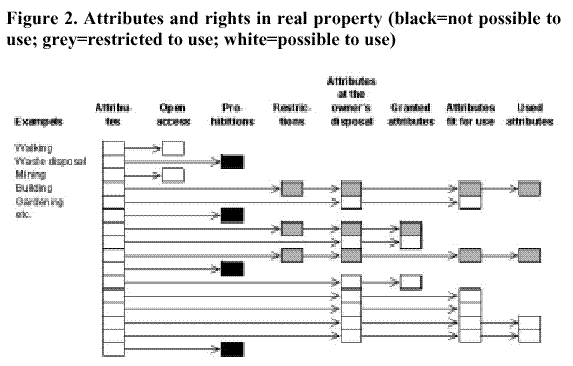Invitation ... Seminar
1. Introduction
Thanks to the rich contributions to the Kick-off Seminar in Bremen, the
research described in the Technical Annex of COST action G9 can now be
further specified. The needed research is specified through the
following
motivation of N sessions, and corresponding calls for papers. The call
is to be understood like the calls for the Bremen seminar: Before the
Madrid
seminar your submit an abstract, implying that you are prepared to
develop
the issue orally at the seminar, and - taking comments into
consideration
- prepare a paper for the seminar documentation.
2. Session A: Typifying real property rights
In his Bremen paper: Aspects of Property Rights and its Alteration,
Hans
Mattsson illustrates how property rights may be typified. Based on the
concept bundle of rights, he focuses on attributes of real property
rights:
Walking, waste disposal, mining, building, gardening, etc. Furthermore,
by means of a shematic he illustrates the 'legal processing' of these
attributes:
Some are prohibited by law, others restricted and/or dependent on
permission.

The way of illustrating the attributes, and the formalization criteria
in general, calls for comments and discussions. What is evidenced,
however,
is the need to specify in a systematic fashion activities pertaining to
immovables:
-
the energy consuming activities: fencing, growing, building, mining,
waste
disposal, etc.,
-
the legal ('symbolic', 'status') activities, by which owner, parties,
and
society 'negotiates' the implication of ownership rights: conveyancing,
mortgaging, granting of easement, subdivision, reallotment, etc.
-
the elements and logic ('calculus') of the 'legal processing'. Can you,
for example, 'add' and 'subtract' rights as suggested by the table
below:
| Examples |
Attributes |
Open access |
Prohibitions |
Restrictions |
Attributes at the
owner's disposal |
Granted
attributes |
Attributes
available
for use |
Used
attributes |
| |
(1)
|
(2)
|
(3)
|
(4)
|
(5) =
(1) - (2+3+4)
|
(6)
|
(7) = (5+6)
|
(8) <= (7)
|
Contributions for this session may be of two kinds:
-
A country specific survey of the most important (frequent) factual and
legal types of activities, including statutory definitions of key
concepts
and if possible national doctrine on 'legal processing' regarding
immovables.
-
Suggestions regarding the formalization of property rights and the
'legal
processing' of these rights.
The first kind of contribution provides for the empirical evidence,
against
which the formalization scheme of the second kind of contribution has
to
be tested.
3. Session B: Comparing processes regarding immovable property
Already before the Bremen seminar, subdivision and to some extent
purchase
procesess were described for Denmark, Finland, and Slovenia, see at
http://www.i4.auc.dk/est/cost/COSThome.html#Material.
Due to time restrictions, the work was not presented and discussed.
Later,
a tentative comparison was made for presentation at the FIG
International
Conference, April 2002, by Erik Stubkjær.
Contributions from other countries, using the UseCase formalism are
invited. Tentatively, the following five basic procedures are to be
described
within the project:
-
conveyancing of title,
-
mortgaging,
-
granting of easement,
-
subdivision, the creation of a new unit of real estate, and
-
reallotment, the transfer of land plots among existing units of real
estate.
Consequently, the description from the above mentioned countries need
supplements.
As in the previous session, the country specific contributions has
to be supplemented with contributions on methodology for comparing the
national contributions and development of joint description framework.
4. Session C and Workshop: Developing Ontologies - Tools and
motivations
At the Bremen seminar, experiences regarding ontology development was
presented.
Also, development tools were mentioned and made available. The
following
presents a semi-formal structuring of the universe of discourse. The
tentative
structuring motivates a tentative list of research questions, which are
presented in a subsequent note.
The UML-based description of subdivision in Slovenia includes the
following
classes: Actor, Activity and Sub-activity, and Attribute. Activities
are
detailled in the UseCase description, and analysed in another
document. The following survey of other classes and sub-classes are
based on the Slovenian description, with as little modification as
possible.
The table arrangement is motivated by space needs, not by content:
Actors include:
-
Authorities
-
Cadastral agency
-
Land Registry
-
Municipality
-
Other local authorities
-
Professionals
-
Notary
-
Responsible surveyor, Surveying company
-
Holders of right in a unit of real estate
-
Owners
-
Mortgagors
-
Neighbors
-
Other holders of rights in the unit
|
Documents include
-
Application
-
Contract
-
Inscription
-
Notice
-
Report
-
Subdivision invoice, Subdivision permission
Each document have following attributes:
-
Signature
-
Location and time of signature
-
Document identification (registration number, date)
|
Other
-
Rules, Decree, Provision
-
Fee,
-
Unit of Real estate
-
Property right
|
Geographic elements includes
-
Boundary, Boundary point, Boundary segment
-
Parcel
-
Plot (or Lot)
|
Erik Stubkjær,
2002-03-11; -08;-07,
est@i4.auc.dk

